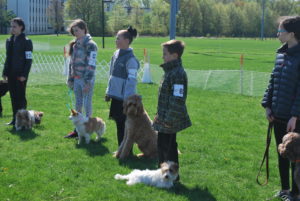Main Content

When learning something new, it helps to first experience the new material under the same conditions. This is called “consistency”. Think of your experience on the first day of school. You don’t know what to expect from your new teacher and this new environment. Over time, consistent routines helped you learn when to sit at your desk and pay attention, how to raise your hand before answering a question, and where to find any materials you needed. By the end of the year, you could probably do all of these things without a lot of reminders from your teacher because you had learned the expected behaviors for your classroom.
Consistency can be found in dog training and is very important for teaching new behaviors. For example, if you use the word “down” to mean both “get your paws off my chest” and “lie down on your pillow,” the dog will have a harder time understanding what you want him/her to do. Be consistent. Save the word “down” for when you mean “lie down” and use a different word, like “off” for jumping up. (Although it’s even better to direct a misbehaving dog to do a specific thing, like “sit”, as opposed to just trying to get them to stop doing something.)
There are many ways to be consistent in your training, such as always using the same word to ask for the same behavior or by staying consistent in the rules of the house (i.e. no dogs on the bed). Here is another simple way to be consistent in your training that will communicate a lot to your dog. Every time you tell your dog to “heel”, step off with your left foot first (the foot closest to your dog’s eyes). Every time you tell your dog to “stay,” along with a hand signal, step off with your right foot first (the foot furthest from your dog’s eyes).
Why be so specific with how you step in “heel” versus “stay”? Doing so becomes a subtle visual cue to your dog that helps them remember the difference between “heel” and “stay”. When they see your left leg (the one closest to their eyes) move, they’ll remember it’s time to walk with you. It’s a little harder for them to see your right leg move so this works well to remind them to “stay”. Teaching your dog this subtle difference can come in handy when they are in a distracting environment, like at the Fair. The trick to success with teaching this cue is that you must be consistent with your footwork. Practice on your own until it feels natural and you don’t have to think too hard about which foot to start with.
Consistency in training is great…until things become too predictable and your dog is not paying attention to you because they already know what to expect. This is when inconsistency becomes a valuable training technique. Imagine you’ve been working with your dog on recall and now they come when called, sit in front of you, and finish back into heel position. Doing this pattern the same way enough times will become routine for your dog so they may decide to skip a few steps. In the dog’s mind, they know the end result is back to heel position. Why bother with the sit at all? Why wait for you to say “finish”? When this happens, it’s time for some inconsistent training.
When you want your dog to wait for a command, mix things up. You can skip the “finish” entirely sometimes and just praise your dog after completing the first part of the recall exercise. Try having the dog sit in front, and then you walk around the dog as if returning from a long sit exercise. Try surprising your dog entirely by praising them as soon as they start coming to you after the signal “come”. If you’re training the drop on recall, keep doing some recalls without the drop. Don’t forget to vary your heeling patterns so your dog doesn’t anticipate the turns or sits. Mixing things up will keep things interesting for you both and keep your dog engaged in the training.
Consistency and inconsistency. Both valuable training tools.
By Beverly Hahn, 4-H Dog Club Leader and Kelly Dziak, 4-H Program Associate, Rutgers Cooperative Extension